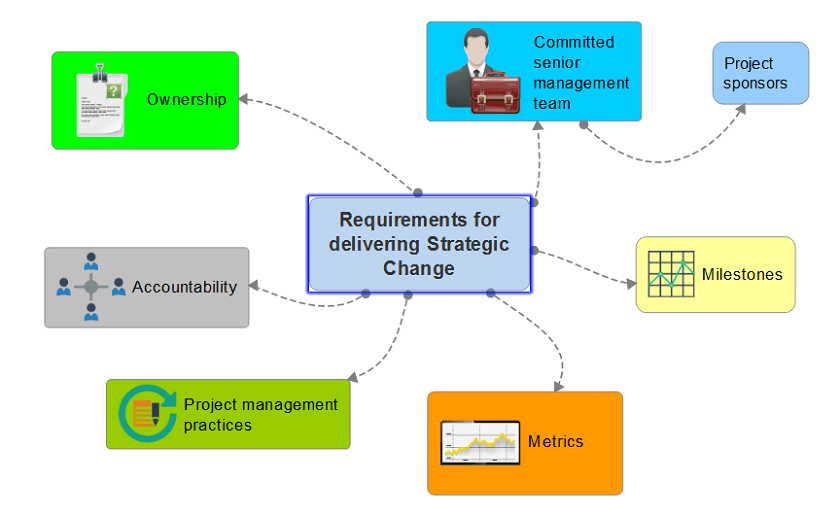Companies that are good at organizational change management complete twice as many strategic initiatives that meet their original time, budget, and content goals. A study called Enabling Organizational Change through Strategic Initiatives, from PMI, shows that if you are good at change management, your organization will:
- Meet the goals of strategic initiatives 65% of the time
- Complete strategic initiatives on-time 64% of the time
- Complete strategic initiatives on budget 63% of the time.
When you compare those figures to companies that are minimally effective at delivering change, they are almost double in every case. The study identifies 5 practices that are important for delivering change effectively, and therefore for completing your strategic projects successfully. Let’s take a look and see how you can implement these in your business.
Well-defined milestones and metrics
Clear measures will help you monitor and control initiatives that have a strategic delivery. Every initiative should have clear success criteria. These set out exactly what success looks like and how the team will know when it has been achieved. You can then measure against these during the project (you’ll have to put sensible metrics in place to do this if they are not already there).
Milestones are points on the project plan that mark a significant event, such as the start or end of a phase. These allow you to track progress against the project’s schedule and identify any slippage.
In your organization: Make sure every project has success criteria set in the business case. These should be monitored and tracked throughout the life of the project to ensure it is still a viable initiative. Each project should also have defined milestones – at least one per project phase.

Committed senior management
Are the business leaders at the top of your organization committed to innovation and growth? Implementing a strategy that will deliver change is sometimes a leap of faith, and you need to know that your colleagues are with you. A senior management team that is dedicated to the delivery of your strategy is essential if you want it to have any chance of success.
In your organization: Work with your peers and those above you to drive support for delivering strategic initiatives. This shouldn’t be difficult: there should be a clear link between the project and the strategic objective it supports. While companies do have to do tactical work throughout the year, these strategic projects should have high-level support and oversight.
Ownership and accountability
People need to feel as if they ‘own’ their part of the strategy. While no one person is solely responsible for completing every single task, there should be someone in an authority position who is accountable for the success of the initiative overall. Their team members should take ownership of the tasks that are assigned to them.
In your organization: Make sure that there are clear lines of responsibility. Set out roles and responsibilities at the start of every initiative. Keep people accountable by building targets into their personal performance objectives for the year. Put methods in place to track progress and ensure your key personnel is empowered to deliver.

Standardized project management practices
Standardized project management practices are in place in 86% of businesses that manage strategic change effectively. This means defining processes for all elements of the project life cycle including:
- Preparation and submission of business cases
- Project selection in alignment with strategic goals
- Resource allocation
- Change, risk, and issue management
- Budget management and financial forecasting.
Good governance helps ensure that these processes are adhered to. Processes should be scalable: not all strategic initiatives have huge budgets and take a long time. To ensure your delivery teams stay nimble and innovative (and not bogged down by too much paperwork) only apply the level of process that you need to get the job done.
In your organization: Find out how many project managers have had formal training in the last 12 months. Upskill those who haven’t. Consider investing in formal accreditation such as credentials from PMI, or the IPMA organization in your country.

Strong sponsorship
Any strategic initiative needs an executive sponsor. Unfortunately, those people who end up in the role haven’t always had prior experience of working on business-critical projects. Sponsors should be able to adequately support the team they are working with who, after all, are doing the hands-on work of delivering the strategy.
The executives who sponsor strategic initiatives should be charismatic and influential people within the organization who can adequately:
- Remove roadblocks
- Champion the initiative at all levels of the organization
- Motivate the team
- Negotiate for resources
- Influence other senior leaders
The project sponsor should also constantly be monitoring the progress at a high level to ensure the project is still on track to deliver something of value and move the business closer to achieving its strategic goals.
In your organization: Consider putting those senior managers who sponsor projects through a program of sponsor training. Make sure they understand how to interpret project data. Give them the tools they need to unblock problems for their project teams.
These five practices will help you deliver strategic change successfully in your organization. Have you tried out these tips? Let us know how they helped you in the comments below.
About the author

Elizabeth Harrin is the author and award-winning blogger behind A Girl’s Guide To Project Management. Get her suggestions for being more productive at work on her blog.



